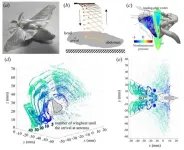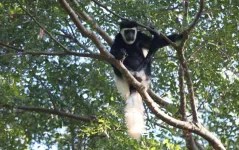US air pollution monitoring network has gaps in coverage, say researchers
2024-10-15
(Press-News.org) The lack of air-quality monitoring capabilities across the U.S. affects the health of millions of people and disproportionately impacts minority and low socioeconomic-status communities, say researchers in ACS’ Environmental Science & Technology Letters. Motivated by a new U.S. Environmental Protection Agency (EPA) standard for air pollution, the team employed a model for fine-scale air pollution mapping using real-world data, and it indicates there is an urgent need to address gaps in the agency’s monitoring network.
“The national air pollution monitoring network aims to act as an umbrella to protect all Americans,” says lead author Yuzhou Wang. “But we saw that unfortunately, millions of people, especially underrecognized populations, will not receive adequate protection from the monitors. Thus, they will receive fewer benefits from the more stringent standard.”
Most of the harmful effects from outdoor air pollution in the U.S. are linked to inhalation of fine particulate matter (PM). These suspended particles, like soot or liquid aerosol droplets, are smaller than 2.5 micrometers in diameter, garnering the designation PM2.5. In February 2024, to better protect Americans from health burdens caused by inhaling particles, the EPA adopted a more stringent standard for PM2.5.The EPA tracks compliance with air pollution standards through a network of about 1,000 costly and highly accurate monitoring stations placed in cities and towns nationwide. Prior research shows that people of color and people with low socioeconomic status living in the U.S. are disproportionately affected by outdoor PM2.5 exposure. However, these populations have fewer monitoring stations than other areas to measure air pollutants, meaning they may not be fully protected by the tighter air pollution standards.
While the EPA is now modifying the national air pollution monitoring network to account for environmental justice, the adequacy of this network to correctly identify areas that do not meet the new air pollution standards has not been thoroughly investigated. So, researchers led by Joshua Apte used a statistical model to identify gaps in the monitoring network’s coverage across the continental U.S. The model is based on observations and geographic variables, called an empirical model, and it identifies potential areas with PM2.5 levels that exceed the agency’s new lower standard.
To assess the monitoring gaps, Apte and colleagues compared PM2.5 levels from 2017 to 2019 at both monitored and unmonitored locations, using PM2.5 level predictions from the U.S. Center for Air, Climate, and Energy Solutions and population data from the 2020 U.S. Census. Their findings revealed that the network misses pollution hotspots and underestimates exposure disparities, which highlights the need for enhanced monitoring in historically underrecognized communities. Overall, they find that:
About 44% of highly populated metro areas in the U.S., which affect about 20 million people, have inadequate monitoring networks to comply with new EPA air quality standards.
PM2.5 hotspots identified with monitoring data and predicted by the model have significantly higher percentages of people of color and people with low socioeconomic status compared to the overall population.
Around 2.8 million people live in PM2.5 hotspots that are not captured by the air monitoring network.
“Fortunately, even adding 10 monitors in the right places could make a big difference in correctly identifying which cities are breathing unhealthy air,” says Apte. However, he adds that “our network of about 1,000 official regulatory air monitors is generally not well-suited for capturing exposure disparities in every city in the country. There are just too few monitors to capture every hotspot.”
The team identified metro locations to add new air pollution monitors across the U.S. that could help identify large populations that currently breathe air more polluted than the EPA’s new standards. The metro areas are in Texas, Ohio, California, Wisconsin, Pennsylvania, Missouri and Idaho.
The authors acknowledge funding from Google.org.
###
The American Chemical Society (ACS) is a nonprofit organization chartered by the U.S. Congress. ACS’ mission is to advance the broader chemistry enterprise and its practitioners for the benefit of Earth and all its people. The Society is a global leader in promoting excellence in science education and providing access to chemistry-related information and research through its multiple research solutions, peer-reviewed journals, scientific conferences, e-books and weekly news periodical Chemical & Engineering News. ACS journals are among the most cited, most trusted and most read within the scientific literature; however, ACS itself does not conduct chemical research. As a leader in scientific information solutions, its CAS division partners with global innovators to accelerate breakthroughs by curating, connecting and analyzing the world’s scientific knowledge. ACS’ main offices are in Washington, D.C., and Columbus, Ohio.
Registered journalists can subscribe to the ACS journalist news portal on EurekAlert! to access embargoed and public science press releases. For media inquiries, contact newsroom@acs.org.
Note: ACS does not conduct research but publishes and publicizes peer-reviewed scientific studies.
Follow us: X, formerly Twitter | Facebook | LinkedIn | Instagram
END
ELSE PRESS RELEASES FROM THIS DATE:
2024-10-15
A system of wearable sensors and machine learning can continuously monitor factory workers for signs of physical fatigue. Factory work can be physically strenuous, and a safe and ethical workplace must ensure that workers do not become overly fatigued, which can increase the risk of injury and accident, cause chronic health problems, and also impair performance. A system designed by Ping Guo, Qi Zhu, and colleagues measures heart rate, heart rate variability, skin temperature, and locomotor patterns ...
2024-10-15
A study investigates the evolution of beneficial bacteria that live inside and on the surface of farming ants. Attine ants farm fungi, in one of the natural world’s best-studied mutualistic symbioses. In the 1990s, the picture of this mutualism was expanded to include another partner: an actinobacteria, Pseudonocardia, which lives on the ants’ cuticle—their hard exoskeleton—where its cultures are fed by secretions of subcuticular glands. Pseudonocardia is known to kill the fungal pathogen Escovopsis, that might destroy the ants’ mutualistic fungus. Jacobus J. Boomsma and colleagues sequenced samples ...
2024-10-15
A collection of 15 articles from the Polarization and Trust Special Feature explores the complex nature of the emotional divide between political opponents, using approaches from a variety of disciplines, including political science, psychology, sociology, and economics. The articles emerged from a 2023 workshop on “Directions of Polarization, Social Norms, and Trust in Societies,” held at MIT and organized by Kati Kish Bar-On, Eugen Dimant, Yphtach Lelkes and David Rand. Researchers from a number of teams identified ways in which partisans mistrust and inaccurately perceive their political opponents, and other teams examined why such inaccurate ...
2024-10-15
The silkworm moth (Bombyx mori) is an insect that no longer flies due to domestication. The males use their antennae to detect pheromones emitted by females and respond very acutely, and have been used as model insects for the study of their odor source localization. Flying insects flap their wings when they fly, and silkworm moths are also known to flap their wings (called fanning) when they detect pheromones, even though they do not fly. As pheromone molecules move through space in the air, the air flows ...
2024-10-15
Obesity is a widespread public health challenge in the Middle East, maintaining prevalence in 54.2% of women and 31.4% of men in this region. Overweight and obese women have a higher risk of hypertension and cardiovascular risk factors than women with a standard BMI, according to an analysis of the ANCORS-YW STUDY presented at ACC Middle East 2024. The findings highlight the urgent need for targeted interventions that address socioeconomic determinants of health to reduce the cardiovascular risk ...
2024-10-15
In a growing and changing world, we need to find ways of putting food on everyone’s table. Pesticides have enabled mass cultivation on an incredible scale, but they can have harmful secondary effects on humans and wildlife, and pests are rapidly evolving to overcome them. To overcome this challenge and develop the sustainable and resilient agriculture of the future, scientists writing in Frontiers in Science explore the potential of induced resistance. Like a vaccination for plants, it deliberately triggers a plant’s immune system, so that when the plant encounters a similar ...
2024-10-15
Seven New Frog Species Discovered in Madagascar: Sounds Like Something from Star Trek
An international team of researchers have discovered seven new species of tree frogs that make otherworldly calls in the rainforests of Madagascar. Their strange, high-pitched whistling calls sound more like sound effects from the sci-fi series Star Trek. As a result, the researchers have named the new species after seven of the series' most iconic
If you think all frogs croak, you’d be wrong. Seven newly discovered species from the tree frog genus Boophis, found across the rainforests of Madagascar, emit special bird-like whistling ...
2024-10-15
Two thirds of Key Biodiversity Areas (KBAs) in tropical forests are experiencing new temperature conditions as our climate changes, research shows.
KBAs identify the most important places on Earth for species and their habitats.
The new study – by Exeter, Manchester Metropolitan and Cambridge universities – assessed 30 years of temperature conditions below the forest canopy in KBAs in tropical forests worldwide.
It found that 66% of KBAs in tropical forests have recently transitioned to new “temperature regimes” (more than 40% of temperature measurements being outside the range previously recorded ...
2024-10-15
NEW YORK, NY — How do we distinguish threat from safety? It’s a question important not just in our daily lives, but for human disorders linked with fear of others, such as social anxiety or post-traumatic stress disorder (PTSD). The microscope image accompanying this press release, from the laboratory of Steven A. Siegelbaum, PhD, at Columbia’s Zuckerman Institute, displays a powerful technique scientists used to help us find an answer.
The scientists were investigating the hippocampus, a brain area that plays a key role in memory in humans and mice. Specifically, they focused on the CA2 region, which is ...
2024-10-15
In a new study published in Nature Communications Biology, wildlife rangers from the Uganda Wildlife Authority have demonstrated their ability to generate precise and reliable data on lion populations in Uganda’s Nile Delta, a critical stronghold for African lions.
The study reveals that wildlife rangers, a critical component of global conservation efforts but often underutilised in scientific research, can play a pivotal role in the conservation science surrounding the world’s most beloved big cat.
Rangers are effective at monitoring lions and are an underutilised resource
The study showed rangers ...
LAST 30 PRESS RELEASES:
[Press-News.org] US air pollution monitoring network has gaps in coverage, say researchers










